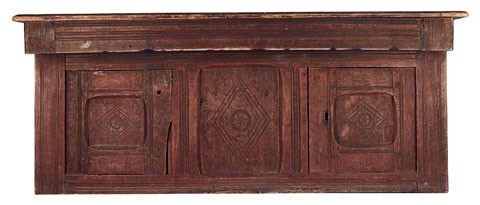
Cupboard head attributed to John Taylor, Cambridge, Massachusetts, 1640–1670. Oak and pine with pine. H. 31", W. 51", D. 18 3/4". (Private collection; photo, Jim Schneck.) The panels have lozenges that were carved with a V-shaped parting tool, and rondels and scrolls carved with a gouge. This effective but simple carving has no exact cognate in New England joinery, even though incised lozenges were a common motif throughout the region.

Chest of drawers with doors attributed to the Ralph Mason and Henry Messinger shop tradition, Boston, Massachusetts, 1635–1650. White oak, red oak, chestnut, maple, black walnut, cedar, cedrella, snakewood, rosewood, and lignum vitae with red oak, white oak, chestnut, and white pine. H. 49", W. 45 3/16", D. 23 3/8". (Courtesy, Mabel Brady Garvan Collection, Yale University Art Gallery.) The turnings on this piece are attributed to Thomas Edsall.
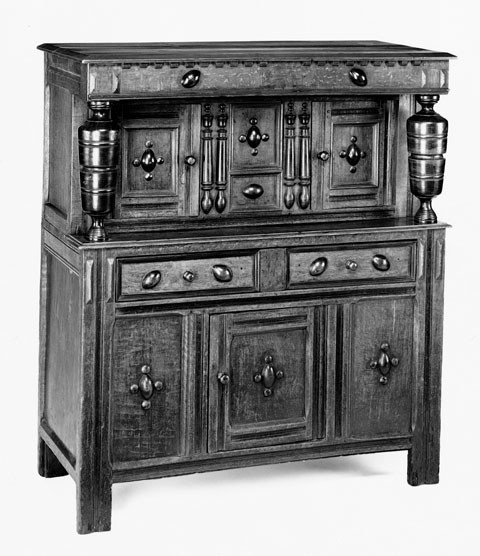
Cupboard attributed to the Harvard College joiners, Cambridge, Massachusetts, 1660–1670. Oak and maple with pine. H. 51 5/8", W. 45", D. 19 1/2". (Courtesy, Concord Museum.)

Rear view of the cupboard illustrated in fig. 3.
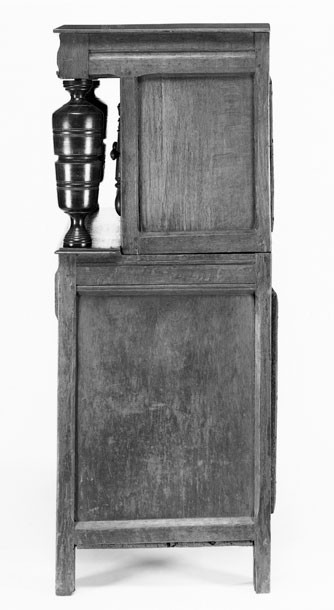
Side view of the cupboard illustrated in fig. 3. Some of the side panels are made of pine rather than oak.
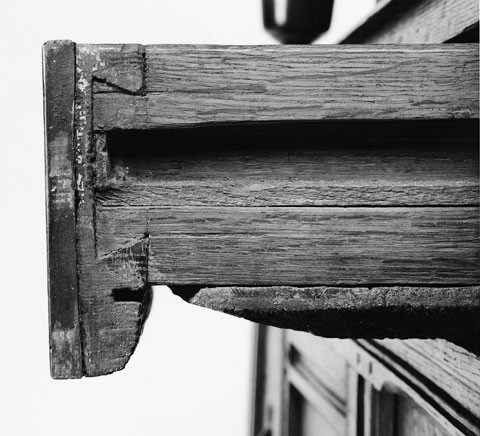
Detail of the dovetailing of a drawer in the cupboard illustrated in fig. 3.
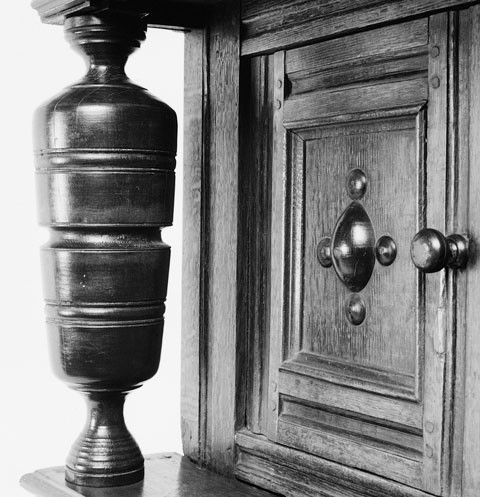
Detail of a pillar on the cupboard illustrated in fig. 3.

Detail of a pair of half-columns on the cupboard illustrated in fig. 3.

Joined cupboard with four drawers attributed to the Ralph Mason and Henry Messinger joinery tradition and the Thomas Edsall turning tradition, Boston, Massachusetts, 1675–1690. Oak, maple, cedar, walnut, and chestnut with oak and white pine. H. 55 5/8", W. 49 1/8", D. 21 3/4". (Chipstone Foundation; photo, Gavin Ashworth.) The frieze ornaments, top of the upper case, several small moldings, and the knobs are modern restorations. The original owners of the cupboard were Isaac (1650–1731) and Elizabeth (Tallman) (d. 1701) Lawton of Portsmouth, Rhode Island, who were married in 1673.
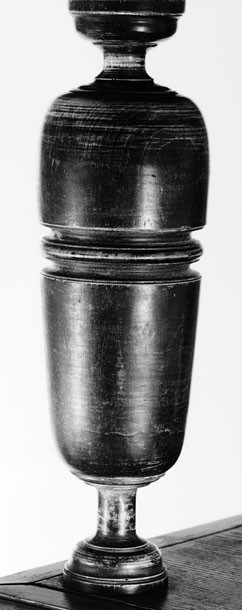
Detail of a pillar on the cupboard illustrated in fig. 9.
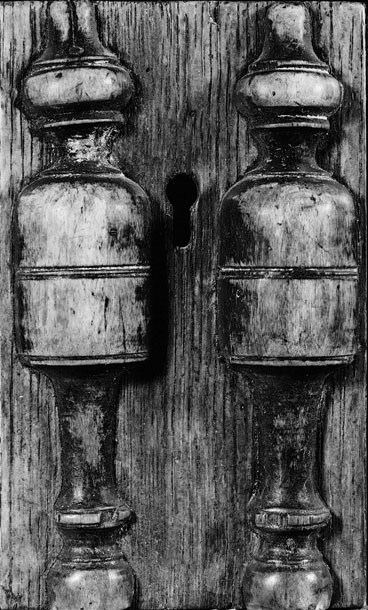
Detail of a pair of half-columns on the cupboard illustrated in fig. 9. These small half-columns differ from those found on the Cambridge group, which are similar to those on the upper section of the cupboard illustrated in fig. 9.
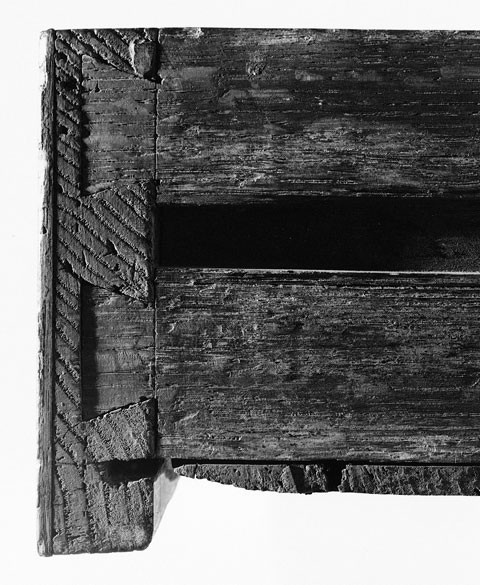
Detail of the dovetailing of a drawer in the cupboard illustrated in fig. 9
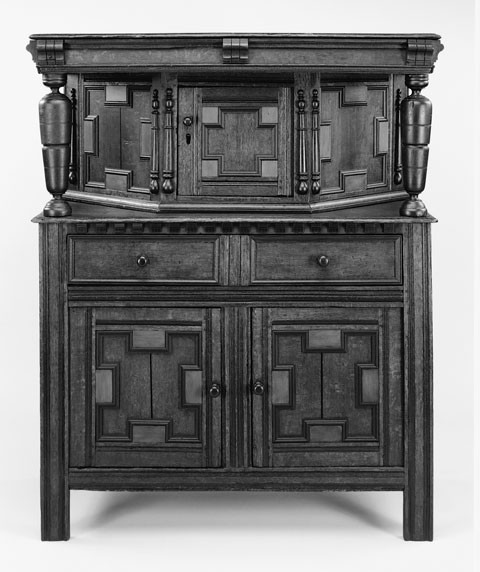
Joined cupboard, Boston or Cambridge, Massachusetts, 1670–1700. Oak and maple with oak and pine. H. 60", W. 49 3/4", D. 23 1/4". (Courtesy, Museum of Fine Arts, Houston; Bayou Bend Collection, museum purchase funds provided by the Theta Charity Antiques Show.) Two corbels, some applied moldings and plaques, the knobs, and the bottoms of the posts are modern restorations. The pillars are slender versions of those on several cupboards that clearly are part of the Cambridge group.
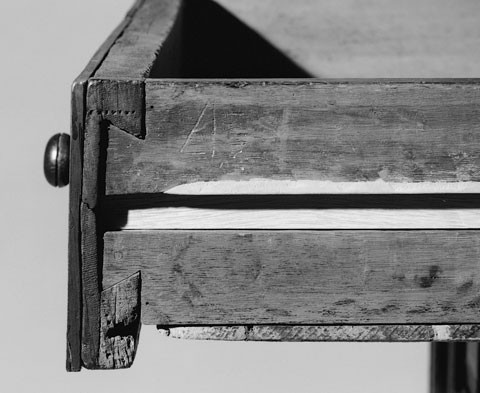
Detail of the dovetailing of a drawer in the cupboard illustrated in fig. 13.
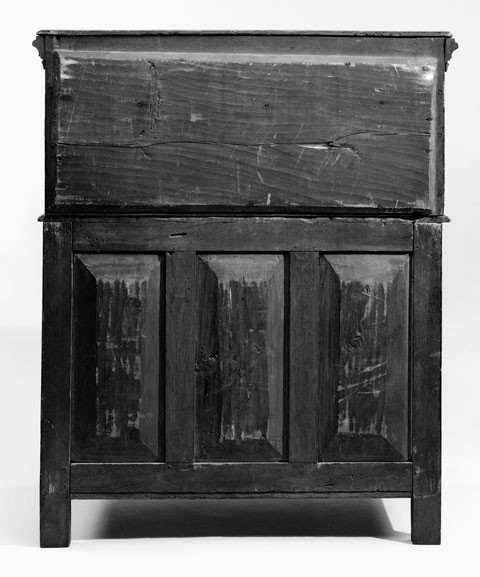
Rear view of the cupboard illustrated in fig. 13. On most of the cupboards in the Cambridge group, the rear façade of the lower case is sealed with nailed-on boards.
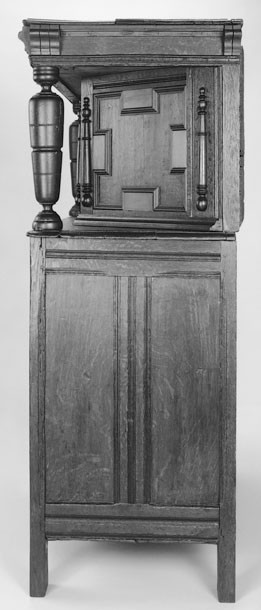
Side view of the cupboard illustrated in fig. 13. On most of the cupboards in the Cambridge group, the side frames of the lower case have one panel rather than two.
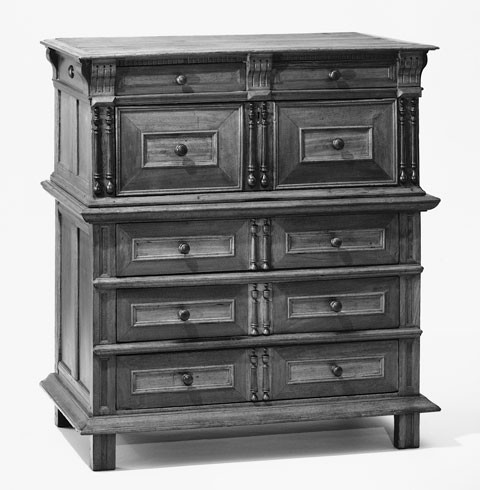
Chest of drawers attributed to the Ralph Mason and Henry Messinger joinery tradition and the Thomas Edsall turning tradition, Boston, Massachusetts, 1640–1670. Oak, cedrella, cedar, walnut, and ebony with oak. H. 51 1/4", W. 47 3/16", D. 23 1/16". (Courtesy, Museum of Fine Arts, Boston, bequest of Charles Hitchcock Tyler.)
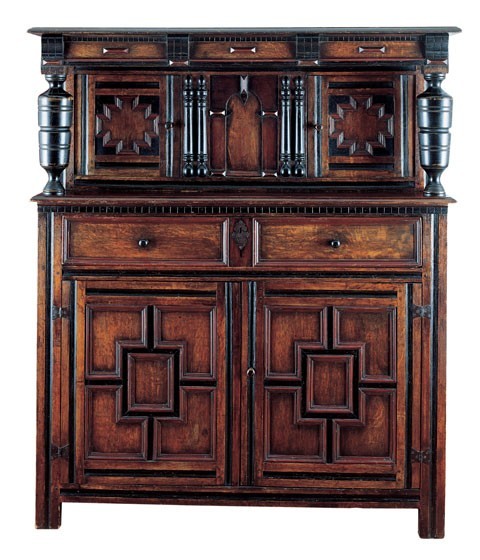
Joined cupboard, Boston or Cambridge, Massachusetts, 1650–1690. Oak, maple, and walnut with oak and pine. H. 61", W. 52 1/2", D. 23". (Private collection; photo, Gavin Ashworth.) The pillars, knobs, and some applied moldings and plaques are modern restorations. The cupboard was reputedly found in Ipswich, Massachusetts.
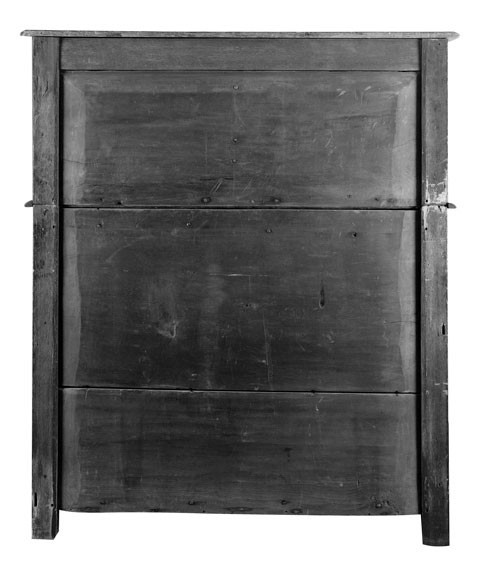
Rear view of the cupboard illustrated in fig. 18.

Detail of the left door of the cupboard fragment illustrated in fig. 1. Each door hinges on 1/2" pins set into holes in the top and bottom of the stile. These pins engage holes in the case. The joiner clearly drilled the holes to make the doors recessed on the hinge side and flush with the façade on the other.
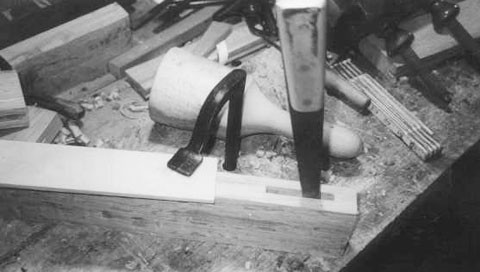
Photos showing how the joiner ran the groove for the panel in the outer stile of the left door of the cupboard fragment illustrated in fig. 1.
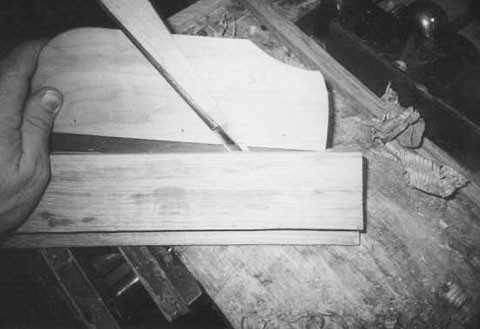
Photos showing how the joiner ran the groove for the panel in the outer stile of the left door of the cupboard fragment illustrated in fig. 1.

Photos showing how the joiner ran the groove for the panel in the outer stile of the left door of the cupboard fragment illustrated in fig. 1.
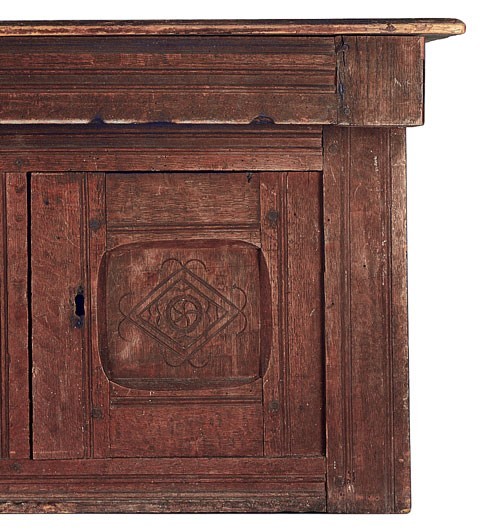
Detail of the chamfering on the right upper post of the cupboard fragment illustrated in fig. 1. The slight chamfer at the juncture of the top rail and the suspended posts is unusual, but it appears to be the result of a mistake rather than a stylistic conceit. This detail is barely discernible and may represent the joiner’s attempt to dress up the posts adjacent to the mistakenly inverted frieze rail.
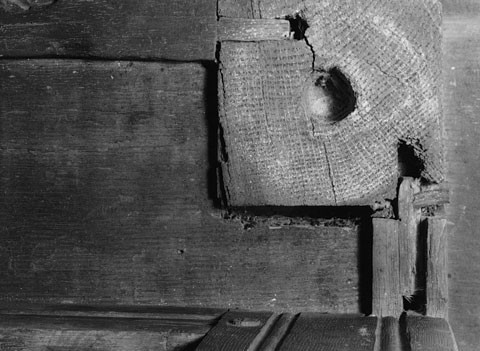
Detail of an open mortise-and-tenon joint on the underside of the upper right post of the cupboard fragment illustrated in fig. 1.
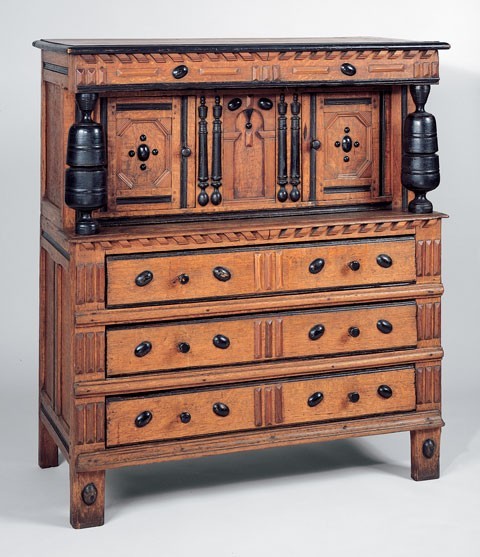
Joined cupboard with drawers attributed to the Harvard College joiners, Cambridge, Massachusetts, 1670–1690. Oak, maple, and cedar with oak and pine. H. 52", W. 46", D. 20". (Private collection; photo, David Stansbury.)

Joined cupboard attributed to the Harvard College joiners, Cambridge, Massachusetts, 1670–1700. Oak and maple with oak and pine. H. 53 7/8", W. 46 5/8", D. 20 1/8". (Courtesy, Winterthur Museum.)
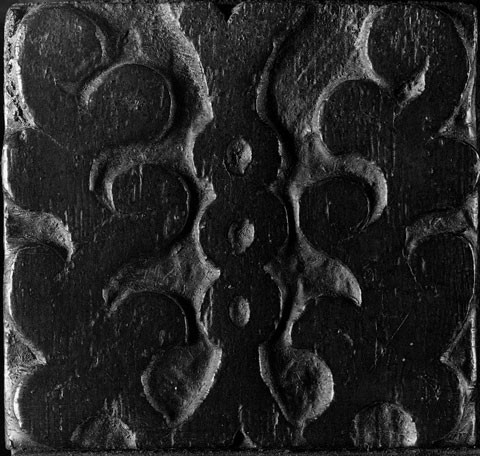
Detail of the left corbel of a Cambridge cupboard (overall not illustrated). (Private collection; photo, Gavin Ashworth.) The corbel is decorated with the carved letter “I”.
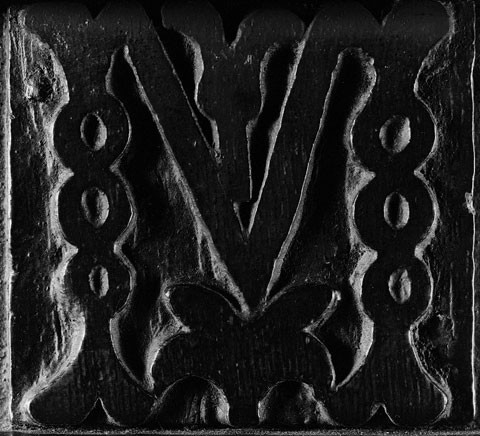
Detail of the middle corbel of a Cambridge cupboard. (Private collection; photo, Gavin Ashworth.) The corbel is decorated with the carved letter “M”.
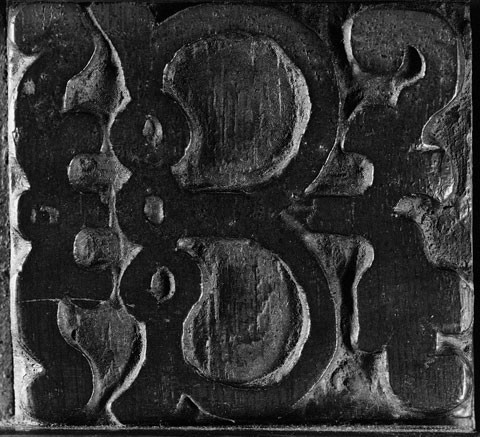
Detail of the right corbel of a Cambridge cupboard. (Private collection; photo, Gavin Ashworth.) The corbel is decorated with the carved letter “B”.

Cupboard head illustrated in figure 1 with its restored lower case and upper pillars. The reproduction base and pillars made to display the cupboard fragment are somewhat conjectural, but many features were not difficult to infer; the Stone cupboard (fig. 3) provided the basic design. Decisions about construction and ornament were based on the assumption that the fragment was made before Boston styles influenced the Harvard College joinery tradition. The lower case was decorated with chamfers and carving matching that on the upper case; the drawer front was decorated with planed moldings; and the pillars were based on English examples of comparable date rather than the tapered urns seen on later Boston and Cambridge cupboards. The rear of the lower case was sealed with nailed-on, chamfered boards, and the front corners of the drawer were joined with one large dovetail.
